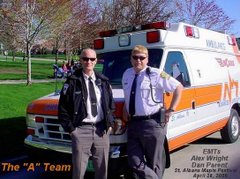I was reading a thread on an EMS forum the other day that had to do with the amount of time spent with the patient on calls. A forum member said something to the effect that we are aware that one of the challenges of rural EMS is that transport times are often comparatively long, but wondered about the challenge of the very short transport time in an urban EMS system. Even though I consider just about everything about Vermont to be rural, I feel I have the two extremes with the two services I run with. In Enosburgh, we often have 30 minutes in the back of the truck with the patient. That's plenty of time to run through every assessment and intervention available and/or appropriate. Obviously the flip side of the coin is that definitive care is also 30 minutes away. In St. Albans, the opposite is often true, with drive-time to NMC frequently in the under-five minute range.
I ran with AmCare in St. Albans for nearly a year before starting to do some shifts at Enosburgh, and I think I understand the meaning of the phrase "trial by fire". Depending on the priority of the patient's illness or injury, we often have to move from a very focused assessment to a treatment plan, and right into treatment within minutes. With very few standing orders, communicating with OLMC can also tie up a minute or two. Don't misunderstand: We learn to do it efficiently, but never at the cost of good patient care.
I find it easier on Enosburgh calls to do IVs, simply because I learned to get them done in a minute or two. I sometimes think that the hardest part about an in-ambulance IV isn't finding the vein, but making sure everything is ready beforehand (flush, lock, catheter, tape, etc.) because there is not an extra set of hands back there to hand you stuff.
One northern Vermont Emergency Medical Technician's journey through a career in Emergency Medical Services.
Why do I write this stuff?? To chase out of my brain the daily craziness of being an EMT in a rural area, despite the great people I get to work with.
Websites of Interest
- My Facebook Page
- Enosburgh Ambulance Flying Club blog
- MedicCast - Podcasts and EMS info
- Council for the Advancement of Pre-hospital Medicine
- EMTLife.com - Great Forums for EMS providers
- Rural EMS Resources
- EMS House - Good Stuff!
- 1st Responder News
- Journal of Emergency Medical Services
- AmCare Ambulance Service's website
- EMT City - Online Forums and Discussions on EMS
- State of VT Office of EMS
- You Tube!
Disclaimer!
The views expressed in this blog are those of the author only. I write what I believe, through my experience and knowledge, to be the truth. These entries do not reflect the views, opinions, policies, or philosophies of AmCare Ambulance Service, Enosburgh Ambulance Service, or anyone related to them other than myself.
Blog Archive
-
▼
2007
(58)
-
▼
April
(17)
- If You See Seven Moons, You'd Better Finish Your B...
- Overworked and understaffed - Revisited
- Maple Fest 2007 - Part 1
- Vermont Bill Addresses Assault on EMS Personnel
- Overworked and understaffed
- A Visit With Angels - Revisited
- Short transport distances/times
- Podcasts
- Advancement of Pre-hospital Medicine
- What have you done today to make you feel proud?
- EMS Chaplain?
- Seatbelt Law Revisited
- Primary Seat-Belt Enforcement Law
- Front Page News?
- Transfer to Dhart
- Jumpin' from a "B" to an "I" to a "P"??
- A Visit with Angels
-
▼
April
(17)
Enosburgh Ambulance's New Truck

DanVTEMT with our new Demers' Millenium ambulance
About Me
The "A - Team"

Alex and I at the Maple Festival, St. Albans, VT, April 2006
Heroes
- Robert Kennedy - A great man and visionary of his time, cut down just when this counrty really needed his leadership.
- WWII Vets - We are losing these heroes all too quickly, but they are still everywhere in our society: Tell one of them "Thank-You", you owe it to them.
- Service Men & Women overseas. Regardless of how you may feel about the war, these men and women are putting it on the line everyday.
- Neil Young - A terrific outlook on life; with a career spanning over 4 decades, his music still gives me chills. And boy can he rock on his "old black" Gibson Les Paul!
My Favorite Quotes
"Few will have the greatness to bend history itself; but each of us can work to change a small portion of events, and in the total of all those acts will be written the history of this generation."
-Robert Kennedy
"It is not the critic who counts: not the man who points out how the strong man stumbles or where the doer of deeds could have done better. The credit belongs to the man who is actually in the arena, whose face is marred by dust and sweat and blood, who strives valiantly, who errs and comes up short again and again, because there is no effort without error or shortcoming, but who knows the great enthusiasms, the great devotions, who spends himself for a worthy cause; who, at the best, knows, in the end, the triumph of high achievement, and who, at the worst, if he fails, at least he fails while daring greatly, so that his place shall never be with those cold and timid souls who knew neither victory nor defeat."
-Theodore Roosevelt
"Citizenship in a Republic,
"Speech at the Sorbonne,
Paris, April 23, 1910
-Robert Kennedy
"It is not the critic who counts: not the man who points out how the strong man stumbles or where the doer of deeds could have done better. The credit belongs to the man who is actually in the arena, whose face is marred by dust and sweat and blood, who strives valiantly, who errs and comes up short again and again, because there is no effort without error or shortcoming, but who knows the great enthusiasms, the great devotions, who spends himself for a worthy cause; who, at the best, knows, in the end, the triumph of high achievement, and who, at the worst, if he fails, at least he fails while daring greatly, so that his place shall never be with those cold and timid souls who knew neither victory nor defeat."
-Theodore Roosevelt
"Citizenship in a Republic,
"Speech at the Sorbonne,
Paris, April 23, 1910


No comments:
Post a Comment